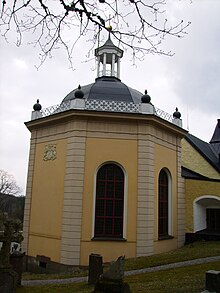Curt von Stedingk
Kurt Bogislaus Ludvig Kristoffer von Stedingk (26 October 1746 – 7 January 1837) was a count and a successful Swedish army officer and diplomat who played a prominent role in Swedish foreign policy during several decades.
Biography
Early life
Von Stedingk was born in Pomerania. His father was major Kristoffer Adam Stedingk and his mother countess Kristina Charlotta von Schwerin. During the Seven Years' War, at which time Sweden was at war with Prussia, then thirteen-year-old Kurt was an ensign in the personal regiment of the Crown Prince of Sweden. After the end of the war, he went to Sweden to claim compensation for damage done to his family's estate in Pomerania. This goal was not achieved, but instead, von Stedingk was introduced to the court, and became friends with the crown prince and his brothers.
Career
Military career
In 1763, after completing his studies at Uppsala, he began his military career, and rose quickly through the ranks in the Royal Suédois regiment in France. By 1788, he had made colonel, and by 1783, he was in charge of a larger army unit in Finland (which then was an integrated part of Sweden). When France went to the aid of the American colonies seeking independence in the American Revolutionary War, von Stedingk left for America in 1779. There, he commanded an infantry unit and was particularly successful during the Siege of Savannah in October of 1779. For this, he was awarded decorated in France and received a lifetime pension. He was also made a member of the Society of the Cincinnati, but the king of Sweden forbade him to wear the insignia as they were awarded to him by a revolting people.
During the Swedish war with Russia started by king Gustav III in 1788, von Stedingk commanded the defence of Savolax. His forces repeatedly defeated Russian forces which greatly outnumbered the Swedes, and von Stedingk was promoted to major general.
Diplomatic career

When peace negotiations were to commence, the king appointed von Stedingk ambassador to Russia. In St Petersburg, he befriended empress Catherine II (called 'the Great') and her successor Paul I. During his many years as ambassador to Russia, von Stedingk was repeatedly promoted, knighted and awarded Swedish and Russian orders because of his success and close friendship with the Russian imperial family. Von Stedingk tried to prevent king Gustav IV Adolf of Sweden from attacking Russia in 1808, but failed. Sweden was defeated in the Finnish War, and lost Finland to Russia. Kurt von Stedingk negotiated the peace treaty in 1809.
After the forced abdication of the Swedish king, he returned to Russia as ambassador, but was called back in 1811 and made a field marshal. He was supreme commander of the Swedish army in Germany - then part of the allied forces fighting Napoleon - from 1813 and commanded it in several large battles (at Großbeeren, Dennewitz and Leipzig). Von Stedingk proceeded through Holstein and accompanied the crown prince to Paris, where the peace treaty was signed.
Kurt von Stedingk spent the rest of his days without other appointments than as head of the Swedish War Academy at Karlberg from 1818 to 1826. In 1826 he was head of the official Swedish party that visited the funeral of emperor Alexander of Russia and the coronation of emperor Nicholas I in Moscow.
Death and afterward
At age 90, von Stedingk finally died in Stockholm, and is said to have been greatly mourned by both the king of Sweden and the armed forces.
References
- This article is mainly a translation of the Swedish Wikipedia article on Kurt von Stedingk.
- Hofberg et al., Svenskt biografiskt handlexikon 1906, Albert Bonnier publishing company. Available at Project Runeberg.
